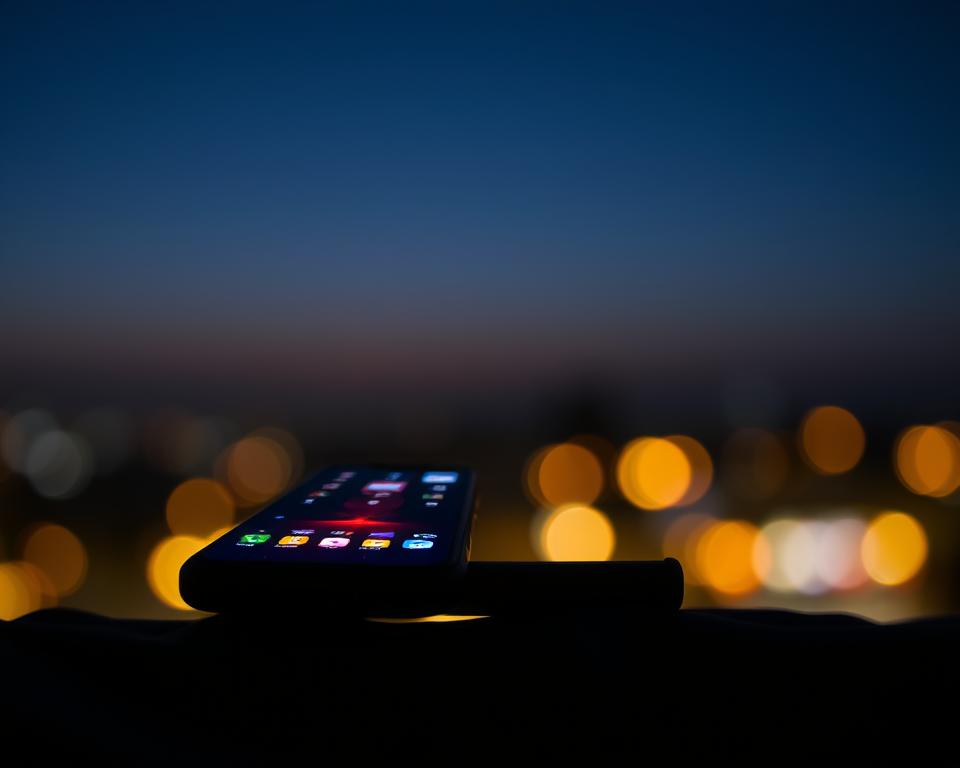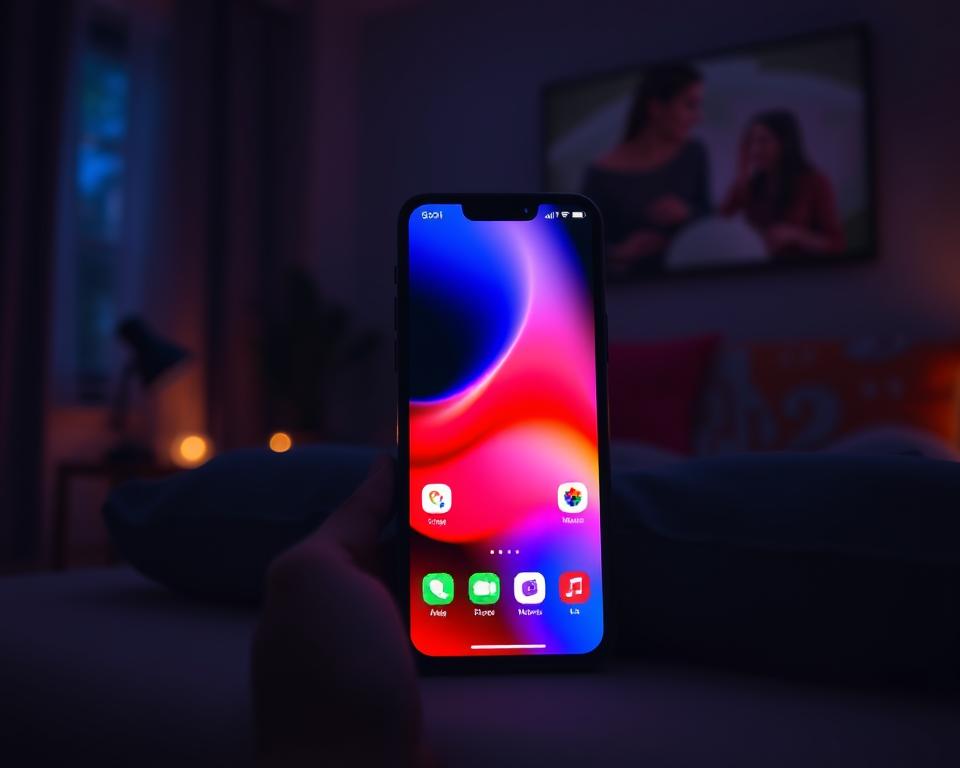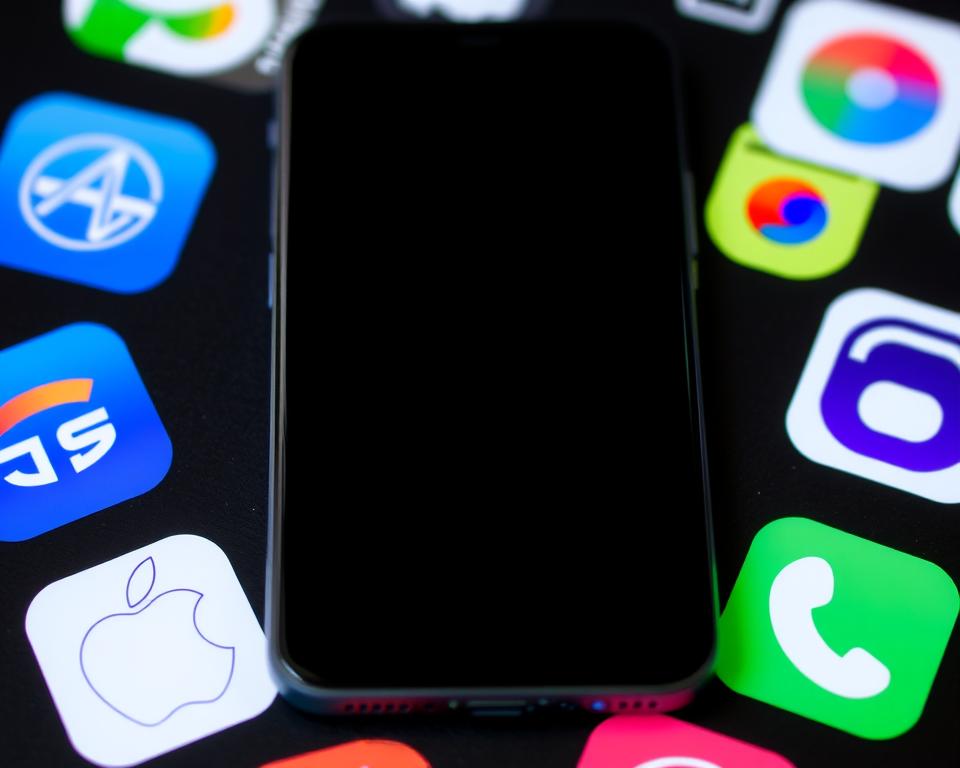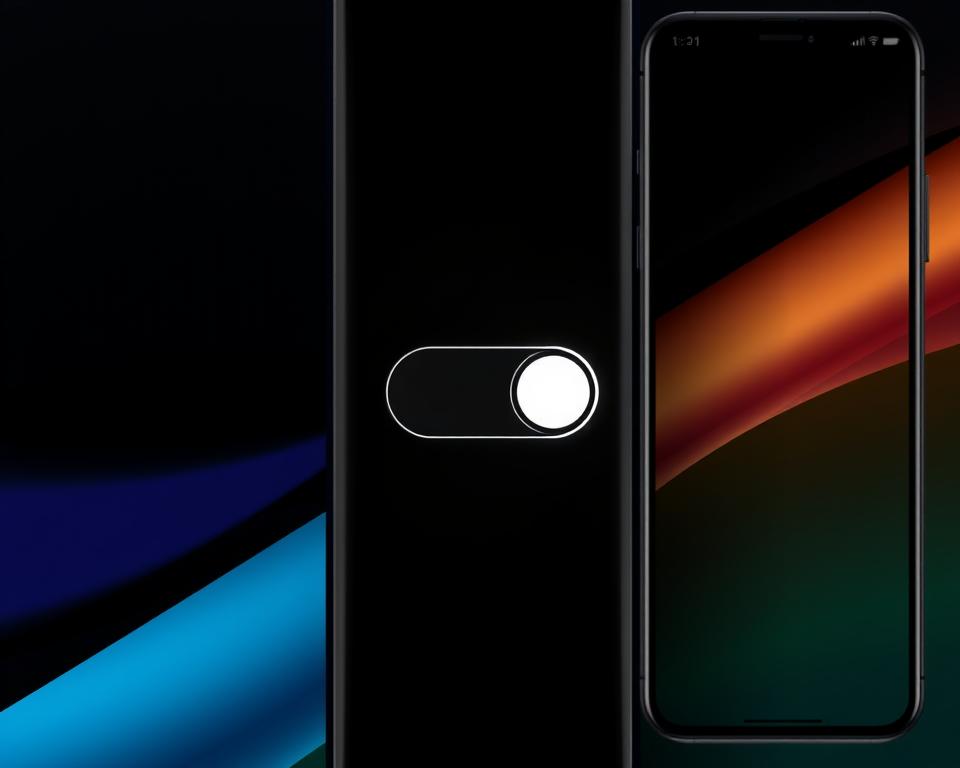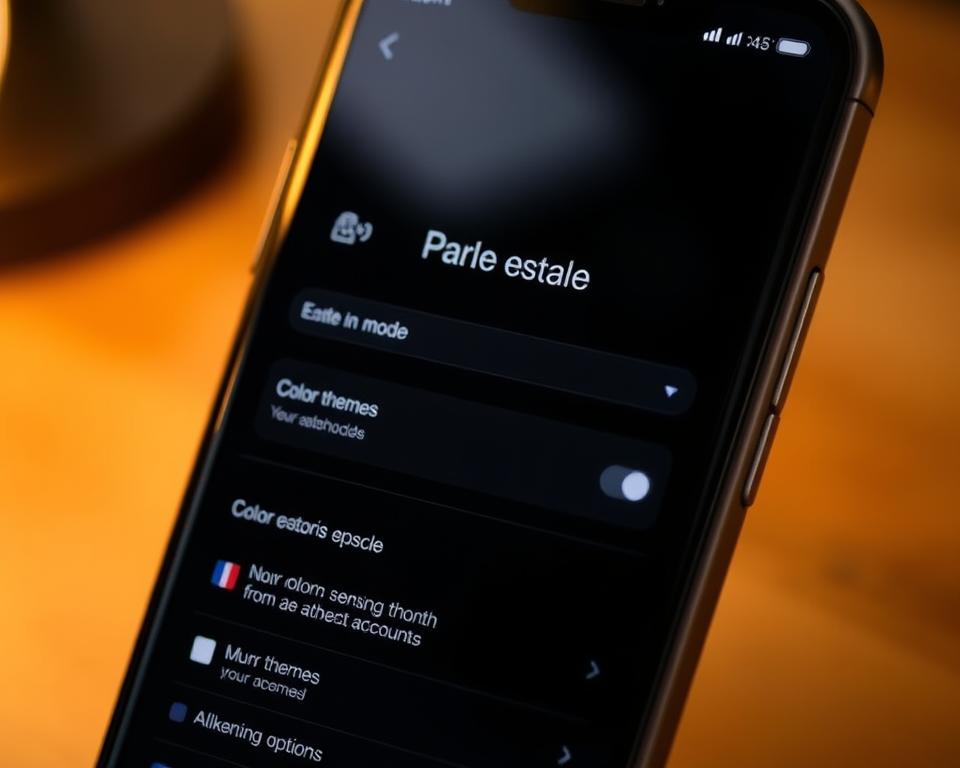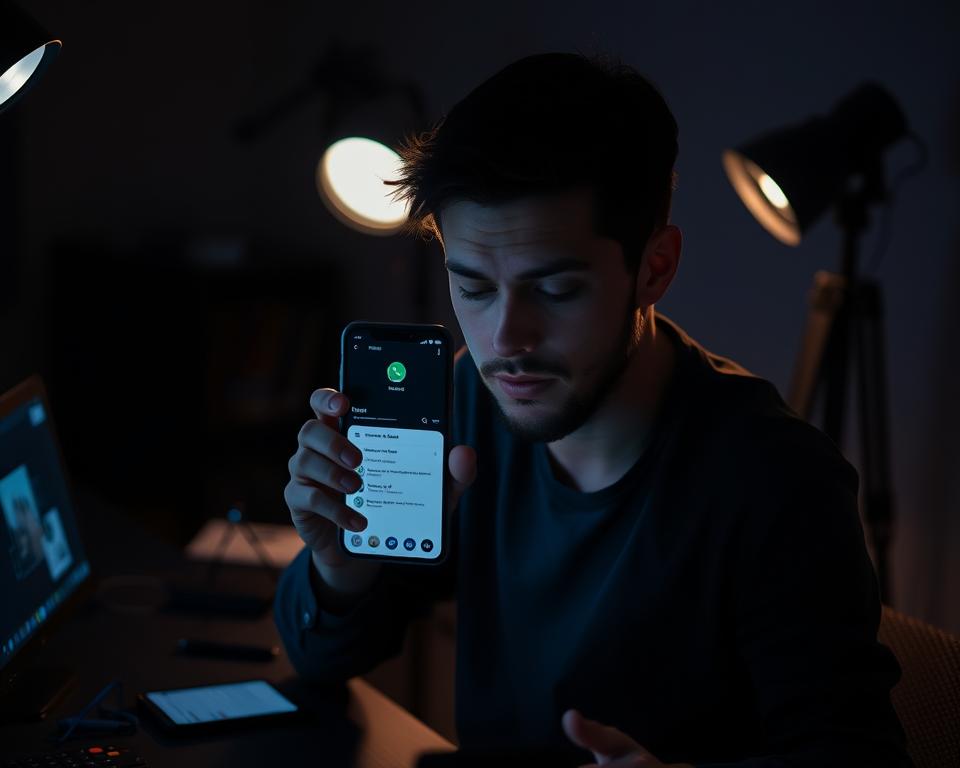In today’s world, mobile devices are a big part of our lives. The user experience (UX) is key to a mobile app’s success. Dark mode is a feature that makes apps look good and is easy to use. It’s become very popular lately.
This guide will take you into the world of dark mode. We’ll look at why it’s so popular, the psychology behind it, and how to design great dark mode interfaces. You’ll learn about the technical side, color theory, and how to add dark mode to your apps.
Table of Contents
Key Takeaways
- Understand the growing popularity of dark mode in mobile apps and its impact on user experience.
- Explore the psychological factors that drive the preference for dark mode and how to leverage them.
- Discover the essential design principles and technical requirements for implementing dark mode effectively.
- Learn color theory and contrast guidelines to create visually striking and accessible dark mode interfaces.
- Implement a step-by-step process to integrate dark mode seamlessly into your mobile app.
Understanding Dark Mode and Its Rising Popularity in Mobile Apps
Technology keeps getting better, making our digital lives more comfortable. One big trend is the rise of dark mode in mobile apps.
The Psychology Behind Dark Mode Preference
Dark mode is popular for many reasons. It can make your eyes feel less tired and strained, especially in dim light. It offers a calm and easy-on-the-eyes look, perfect for long mobile use.
Current Market Trends in Dark Mode Implementation
Dark mode is becoming a big deal in the tech world. Top companies and app makers are adding it to their apps. They see how it can make users happier and more engaged.
Benefits for User Experience and Engagement
Dark mode does more than just look good. It makes using apps easier and more fun. It helps your eyes and saves battery, leading to happier users who stick around longer.
As dark mode becomes more popular, app developers need to keep up. They must listen to what users want and follow the latest trends to create great experiences.
Essential Design Principles for Dark Mode Interfaces
Dark UI design is becoming more popular. It’s important to know the key principles for making great dark mode interfaces. These include choosing the right colors and ensuring good contrast. These steps are crucial for a good user experience.
Crafting Captivating Color Palettes
Choosing the right colors is the first step in designing a dark mode interface. Stay away from colors that are too bright or harsh. Instead, use soft, natural colors that are easy on the eyes. Think about how the main and secondary colors work together to create a cohesive look.
Maintaining Optimal Contrast Ratios
Contrast is key in dark mode design. Text and UI elements should be easy to see against the dark background. Make sure they are readable without straining your eyes. Follow guidelines for contrast, like a 4.5:1 ratio for normal text and 3:1 for large text.
Prioritizing Visual Hierarchy
The visual hierarchy in dark mode interfaces is very important. Use size, weight, and spacing to draw attention to key information. This makes the interface easier to use and understand.
| Design Principle | Key Considerations |
|---|---|
| Color Palette | Muted, earthy tones; Harmonious color combinations; Avoidance of harsh contrasts |
| Contrast Ratio | Minimum 4.5:1 for normal text; Minimum 3:1 for large text; Adherence to accessibility guidelines |
| Visual Hierarchy | Strategic use of size, weight, and spacing; Highlighting important information; De-emphasizing secondary elements |
Following these design principles helps create dark mode interfaces that are both beautiful and functional. The goal is to find the perfect balance between looks and usability. This ensures a smooth and enjoyable experience for dark mode users.
Technical Requirements for Dark Mode Implementation
Mobile apps are getting better, and dark mode is a key feature. It makes apps look good and work well. To add dark mode to your app, you need to know the technical stuff and make sure it works on different phones.
System Requirements and Compatibility
Dark mode needs the right support from the phone’s operating system. Developers must make sure their app works with the dark mode tools from iOS and Android. They need to know which versions of the OS support dark mode and any special rules for each platform.
Development Tools and Frameworks
There are many tools and frameworks to help with dark mode. For making apps that work on many platforms, React Native, Flutter, and Xamarin are good choices. They make it easy to add dark mode and other features that users like.
Also, libraries like Material Design for Android and UIKit for iOS have everything you need for dark mode. They make it easier to develop your app.
Testing Environment Setup
- Set up a testing area that mimics different phones and OS versions. This ensures you test everything.
- Use emulators and simulators from the platform SDKs to check if dark mode works right.
- Use tools like Espresso for Android and XCTest for iOS for automated testing. This makes testing dark mode easier.
By meeting these technical needs, developers can add dark mode to their apps. This way, they can give users a great experience on many devices.
Color Theory and Contrast Guidelines for Dark Mode
Mobile app designers are now focusing on dark mode. It’s important to understand color theory and contrast rules. They must follow WCAG accessibility standards to help users with different visual needs.
Designing dark color schemes needs a careful touch. It’s key to keep text and UI elements clear against the background. Bright, contrasting colors can make things look good but must not hurt your eyes or make things hard to read.
Knowing how colors affect us is crucial. Darker colors can make things feel calm and focused. They help keep important information clear and easy to see. Using color accessibility and dark color schemes helps designers make beautiful, accessible interfaces.
| WCAG Guideline | Minimum Contrast Ratio | Example |
|---|---|---|
| Level AA | 4.5:1 | #FFFFFF on #333333 |
| Level AAA | 7:1 | #FFFFFF on #000000 |
Following these WCAG guidelines and contrast ratios ensures dark mode is accessible. It also improves the user experience.
“The key to successful dark mode design is finding the right balance between visual appeal and accessibility.”
How to Implement Dark Mode in Mobile Apps for Better UX
Adding dark mode to mobile apps can make users happier and more engaged. By using new tech and design ideas, you can make dark mode look great and be easy to use. Here’s how to add dark mode to your app step by step.
Step-by-Step Implementation Process
The first thing to do is set up a good base with CSS variables. These let you switch between light and dark easily.
- Make a color palette and use CSS variables for it.
- Have different colors for light and dark modes.
- Use these colors in your app’s UI.
Code Structure and Organization
Keeping your code organized is key for dark mode. Here are some tips:
- Put light and dark styles in their own files.
- Use conditional rendering or theme-based components to switch modes.
- Make your code modular for easy updates.
Best Practices for Smooth Transitions
Smoothly switching between light and dark modes is important. Here’s how to make it smooth:
- Use animated CSS or JavaScript for smooth transitions.
- Make the dark mode toggle easy to use and look good.
- Think about the timing and length of transitions to avoid being jarring.
By following these tips and using React Native dark mode, you can make your app stand out. Your users will love it.
Managing User Preferences and Settings
Mobile apps aim to give users a smooth and tailored experience. This means managing user preferences and settings well. It includes theme persistence, letting users switch between light and dark themes. It also means using automatic dark mode based on system settings or the time of day.
Theme persistence is key. Users should pick their theme and keep it the same across sessions and device reboots. This keeps the user experience consistent and lets them stick to their preferred look.
Being able to toggle between light and dark themes is also crucial. Users need an easy way to switch themes, like a settings menu or a button. This lets them pick the theme that works best for them, whether for better reading, less eye strain, or just personal taste.
Lastly, automatic dark mode based on system settings or time of day is a big plus. It automatically changes the theme for a smooth experience and cuts down on the need for manual changes.
| Feature | Description | Benefits |
|---|---|---|
| Theme Persistence | Ability to remember user’s preferred theme (light or dark) | Consistent user experience, personalization |
| Light/Dark Theme Toggle | Provide an interface for users to switch between light and dark themes | Customization, improved readability, reduced eye strain |
| Automatic Dark Mode | Automatically switch to dark mode based on system settings or time of day | Seamless transition, reduced manual adjustments |
By adding these user-centric features, app developers can make their apps more personal and fun. This meets users’ needs and boosts user engagement.
Handling Images and Media in Dark Mode
Mobile apps are now using dark mode more often. This means developers have to make sure images, icons, and videos work well in the dark. They need to optimize images and manage special dark mode assets for a smooth user experience.
Image Optimization Techniques
Dark mode changes how we see images. Light images can look washed out in the dark. To fix this, image inversion can change the image’s colors to keep it clear and visible.
Icon and Asset Management
Icons need to match the dark mode look for a unified feel. Developers must create dark mode icons that fit the theme and are easy to see. This might mean making special icons or using colors that work well in the dark.
Video Content Considerations
Dark mode videos need careful planning. Things like video controls, subtitles, and brightness must be thought out. This ensures videos are easy to watch in dim light.
| Technique | Description | Key Considerations |
|---|---|---|
| Image Inversion | Dynamically adjusting the color scheme of images to maintain contrast and visibility in dark mode. | Preserving the original image quality, ensuring consistent appearance across light and dark modes. |
| Dark Mode Icons | Creating specific icon sets that complement the dark mode aesthetic and maintain legibility. | Consistent visual language, accessibility for users with low vision or color blindness. |
| Media Adaptation | Adjusting video player controls, subtitles, brightness, and contrast to optimize the viewing experience in dark mode. | Maintaining visual clarity, preserving the original content’s artistic intent, and ensuring accessibility. |
By using these methods, app developers can make sure images, icons, and videos work well with dark mode. This gives users a consistent and comfortable look in any light.
Performance Optimization for Dark Mode Features
Mobile app developers are now focusing on Dark Mode. It’s important to make sure these features work well. They need to balance looks and performance to create a top-notch app.
One big worry with Dark Mode is how it uses memory. Dark screens use more resources because of their colors. Developers must find ways to use less memory, like smart image handling and color choices.
Battery life is also a big deal. Dark Mode can help save battery, but it can also hurt it if not done right. It’s important to make sure the app uses energy wisely, so it doesn’t drain the battery too fast.
| Metric | Light Mode | Dark Mode |
|---|---|---|
| Memory Usage | 15 MB | 18 MB |
| Battery Drain | 4% per hour | 3% per hour |
| FPS (Frames per Second) | 60 FPS | 58 FPS |
By optimizing Dark Mode, developers can make sure users love it. They can keep the app running smoothly and save battery. A well-made Dark Mode can make users happier and more engaged.
“Balancing aesthetics and efficiency is the key to delivering a remarkable Dark Mode experience.”
Testing and Quality Assurance for Dark Mode
Creating a good Dark Mode for mobile apps needs a detailed testing and quality check. This makes sure users have a smooth experience and the app works well on different devices.
User Testing Methodologies
Testing Dark Mode through A/B testing and usability testing is key. A/B testing helps see how users like Dark Mode compared to the usual light mode. Usability testing gets direct feedback on how easy and nice Dark Mode is to use.
Device Compatibility Testing
Testing Dark Mode on many devices and systems is vital. Cross-device testing makes sure it works well on all kinds of screens and systems. This helps find and fix any problems.
Performance Metrics Analysis
Looking at important metrics shows how well Dark Mode works. Things like how much users enjoy the app, how well they can do tasks, and how long the battery lasts are important. Keeping an eye on these helps make Dark Mode even better.
| Metric | Description | Importance for Dark Mode |
|---|---|---|
| User Engagement | Measures user interactions with the app, such as session duration and frequency | Indicates if Dark Mode enhances user engagement and satisfaction |
| Task Completion Rate | Tracks the percentage of users who successfully complete key tasks in the app | Ensures Dark Mode does not hinder task completion or usability |
| Battery Life | Monitors the impact of Dark Mode on device battery consumption | Validates the energy-saving benefits of Dark Mode implementation |
“Thorough testing and quality assurance are essential for delivering a seamless Dark Mode experience that meets user expectations and improves overall app performance.”
Common Challenges and Solutions in Dark Mode Implementation
Developers face many challenges when adding dark mode to mobile apps. One big issue is color inconsistencies. The app’s colors might not smoothly switch between light and dark modes. This can make the app look jarring and hurt its look.
Another problem is readability issues. Making sure text, icons, and other parts of the app are easy to see in dark mode is hard. This is especially true for apps with lots of content or complex designs.
Theme switching bugs are also common. These bugs happen when the app doesn’t change its look right when switching between light and dark modes. This can cause visual problems and make users unhappy.
Overcoming Dark Mode Challenges
To solve these problems, developers should follow some key steps. This includes:
- Designing a color scheme that works well in both light and dark modes. It should have good contrast and be easy to read.
- Testing the app well when switching themes. This ensures a smooth change between modes.
- Using strong error handling and backup plans. This helps deal with unexpected issues and user actions.
- Keeping the dark mode up to date. This means checking for new platform updates or design trends.
By tackling these common issues, developers can make dark mode experiences better. They will be visually consistent, easy to read, and bug-free. This will make the app more enjoyable for users.
“Implementing a well-designed dark mode is not just about flipping a switch; it requires careful attention to detail and a thoughtful approach to ensuring a cohesive, accessible, and responsive user experience.”
Accessibility Considerations for Dark Mode
Dark mode in mobile apps is getting more popular. It’s important to make sure everyone can use it. This means making sure it works for people with visual issues, using screen readers, and thinking about color blindness.
Designing for people with visual impairments is key. Screen readers help them, and apps need to work well with these tools. It’s important to test and make sure the app is easy to use with audio and text.
Color blindness is also a big deal. Color blindness affects many people. Using colors that are easy to see is important. Designers need to pick colors that everyone can see well.
| Accessibility Consideration | Key Strategies |
|---|---|
| Visual Impairments |
|
| Color Blindness |
|
By focusing on these accessibility considerations, app developers can make dark mode better for everyone. This makes the app more enjoyable and follows inclusive design principles.
“Designing for accessibility should be a core part of the development process, not an afterthought.”
Future-Proofing Your Dark Mode Implementation
Dark mode is getting more popular, and it’s key to keep your app’s dark mode up to date. New tech like adaptive interfaces and AI-driven theming will change how we design dark mode.
Embracing Adaptive Interfaces
Adaptive interfaces are a big deal for dark mode. They make your app’s UI match your device settings, looking great in any light. With design system integration, your dark mode can change to fit what users like and what their devices can do.
Harnessing AI-Driven Theming
AI-driven theming makes dark mode even better. Smart algorithms adjust colors and contrast based on how you use your app and your environment. This means your dark mode stays cool and personal, even as your tastes change.
Maintaining and Updating Your Dark Mode
To keep your dark mode working well, you need a plan for updates. Listen to what users say, check if it works with new systems, and keep up with trends. This way, your dark mode stays a hit with your users.
By using new tech, focusing on adaptive interfaces, and keeping your dark mode fresh, you can make sure it stays great for years. Your app will look amazing and meet your users’ needs, now and in the future.
Conclusion
Dark mode in mobile apps is now key for a good user experience (UX). It’s about understanding what users like and keeping up with trends. This way, apps look better and feel more comfortable to use.
For dark mode to work well, designers must follow important rules. They need to make sure colors are clear and switching between modes is smooth. Developers must also test their apps well to ensure a great experience for users.
More and more people want apps that are easy to use and look good. By following dark mode best practices, developers can make their apps stand out. This meets the needs of tech-savvy users and improves the app’s overall look and feel.







